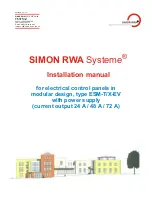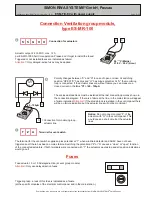
Installation manual ESM-T/X-EV (24 A / 48 A / 72 A)
Page 10/20
SIMON RWA SYSTEME GmbH, Passau
ESM-T/X-EV with power supply
Fault status: The discharge end voltage can be reached by a longer emergency current mode
Fault description
Possible cause
on
blinks
Procedure
Fault status:
Accu is defective
fault description
Possible cause
on
blinks
Procedure
Fault status: Overload
at the status o24, H and D
Fault description
Possible cause
on
blinks
Procedure
Indication at the control
electronics, LB-1*0
LED “mains” LED “O.K.”
Fault indications and causes
Indication at the control
electronics, LB-1*0
LED “mains” LED “O.K.”
If the lead accus have been
discharged a short time ago by a
longer emergency current mode,
in mains operation the accu
voltage could still lie below the
discharge end voltage of 21,5 V.
As long as the charging unit fails to
bring the accu voltage over 21,5 V,
the control electronics stays in the
fault indication mode.
Indication at the control
electronics, LB-1*0
LED “mains” LED “O.K.”
Dublications, also in extracts, are only legal with express authorisation from SIMON RWA SYSTEME GmbH Passau
®
In particular time intervals the
control electronics, LB-1*0 cuts off
the charge. During this time the
accu gets proved. If the accu
voltage is below 21,5 V, the control
electronic assumes that the accu is
defective. The accu couple is
charged in mains operation
permanently.
The SHEV system works, but the
fault indicataion ´O.K.´blinks.
Furthermore all the ventilation
functions are disabled.
One of the status outputs ´+24´,
´H´ or ´D´ are overcharged resp.
short circuited.
Disconnect all status outputs from the
control electronics, LB-1*0. If the fault
indication goes out immediately, it must be
proved which wire causes the fault by
connnecting successively every single
status wire. The charge at the 24
may not be higher than 500mA and at the
outputs H and D it may not exceed 70mA.
In order to distinguish whether the accu is
simply discharged or if it is defective, you just
need to dis- and reconnect the accu couple
(5 s). Then the fault indication should go out
and stay out (wait 10 minutes).
The SHEV system works, but the
fault indication LED ´O.K.´blinks.
The SHEV system works, but the
fault indication LED ´O.K.´blinks
Disconnect the accu from the control
electronics LB-1*0. Then measure the
voltage at the accu couple for about 1 min. If
the voltage is less than 21,5 V it can be
assumed, that the accu couple is defective.





















